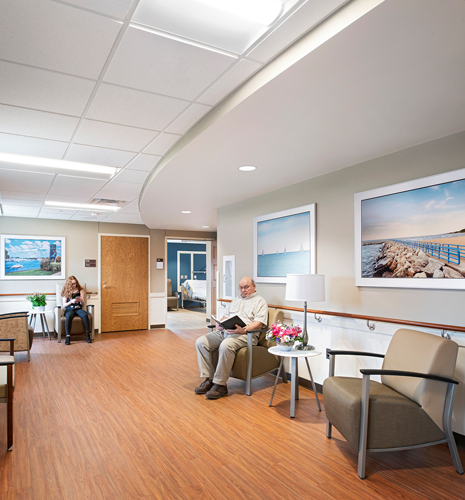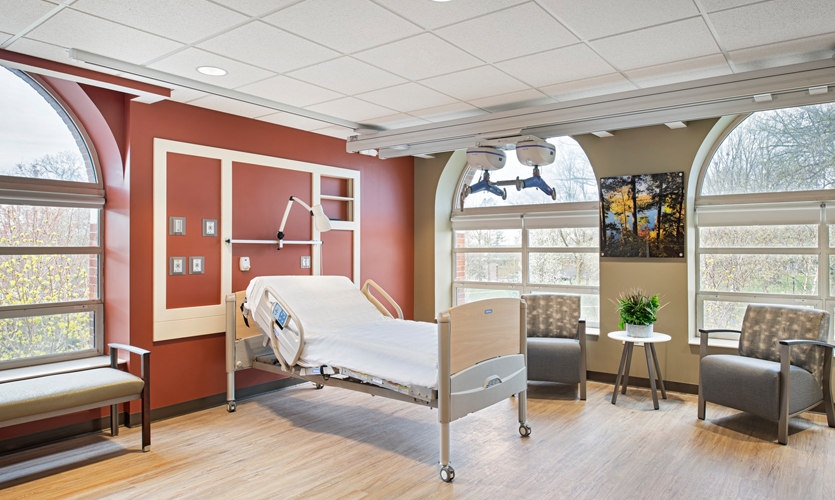VA Medical Center Interior Renovation
Department of Veterans Affairs

Projects > VA Medical Center Interior Renovation
Department of Veterans Affairs
SSOE is providing multi-disciplinary design services to the four Veteran Affairs (VA) medical centers in Michigan as part of an Indefinite Delivery, Indefinite Quantity (IDIQ) contract. The renovation of the second floor of Building 83 is one project from the IDIQ, on the VA Battle Creek campus.
This project focused on the renovation of 18,170 SF of space in the Nursing Home Care Unit (NHCU). The existing space contained large, multi-bed dorm rooms which were reconfigured to private bedrooms and bathrooms in compliance with current VA design criteria. A portion of the rooms were designed to accommodate bariatric residents and other specialized needs.
The entire interior of the second floor was demolished to provide a floor plan that would meet the current and future needs of the residents and staff. The secondary electrical, HVAC, plumbing, and medical gas systems were upgraded and replaced. All items were required to be coordinated with the previously renovated first floor plan and systems.
In addition to privacy, patient safety and security was critical to the success of this project. SSOE’s design services included nurse call systems, upgrades to the building fire alarm systems, wireless network design for improved coverage, IP security camera additions, and Network Video Recorder (NVR) storage expansion to provide adequate video storage.
The future residents of the facility and their care was the leading factor in the design. New nursing stations were created at the center of each patient care area to allow for better patient observation. Open dining and family rooms for visitors, a large dayroom for activities, and bedrooms with adjoining bathrooms are also examples of patient focused care. All of the finishes and space planning focused on eliminating the existing institutional feeling and providing for a welcoming and residential aesthetic.


Have a question regarding our services? Need assistance with an upcoming project? Send us an email. We look forward to hearing from you and will follow up soon.
© SSOE GROUP 1948-2025
Legal | Privacy Policy | CA Privacy Policy | Cookie Policy
Website designed and developed by
Raincastle Communications, Inc.

 3T MRI Renovation
3T MRI RenovationAutodesk Construction Cloud (ACC) is SSOE’s enterprise-wide project delivery platform. We partner with the Autodesk Product team and have research access. Use of the AI Assistant allows our design teams, owners, and general contractors the ability to query the project specifications for quality, answers, and more rapid responses to RFIs, submittals, or issues.
SSOE has developed a proof-of-concept to use an AI Agent to act as a Master Engineer and Architect trained in SSOE’s processes, best-known-methods, and trainings. Our data structure is being remodeled to enable better use of our proprietary knowledge to train the agent on the ‘SSOE way’.
SSOE is actively piloting AI Chat large language models (LLMs) or copilots that use Natural Language Processing (NLP) to streamline both design and development tasks, transforming how our teams interact with software and each other.
By integrating chat LLM engines into platforms like Revit, we’re enabling users to prompt complex actions using simple, conversational commands. In Revit, this means automating tasks such as modeling elements, cleaning up parameter data, managing annotations and dimensions, and organizing sheets—without writing scripts. These automations and quality prompts can be shared across project teams, accelerating workflows and reducing manual effort.
Similarly, our internal Software Development Community is leveraging GitHub Copilot to expedite coding tasks. Developers can generate and refine code using NLP prompts, tapping into GitHub’s extensive Repo to move faster from concept to implementation.
Together, these tools represent a shift from traditional, expert-driven scripting to intuitive, AI-assisted automation, unlocking new levels of efficiency and scalability across our projects.
We helped our client visualize and optimize façade design for occupant comfort—long before breaking ground through the use of the Autodesk Forma tool. It allows the designer to rapidly experiment with the building’s geometry and façade design to promote sustainability, prioritizing quality of spaces and comfort for end uses, especially in extreme climates (daylighting and microclimate analysis tools) at the project’s exact geographic location, using location-specific environmental data.
Discover how SSOE is using Autodesk Forma to improve sustainability outcomes for industrial projects: SSOE Group: Improving sustainability outcomes for industrial projects with Autodesk Forma.
SSOE is utilizing Microsoft Copilot Edge and M365 to significantly enhance work efficiency and accuracy across various departments. Copilot is accessible to all staff after training. Key areas of application include using it as a writing assistant, for idea generation, document summarization and generation, research assistant, excel assistant, programming code assistant, language translations, product comparison and data analysis. Use of Copilot has become part of the everyday life of SSOE employees who have identified key ways it can help them become more efficient with their daily tasks as well as more accurate in their deliverables.
Today, 100% of SSOE employees have taken the voluntary training and have access to Copilot Edge, achieving early our October 1, 2025 goal.
We found ourselves in need of a more robust tool to enhance resource forecasting and staff assignment capabilities. Instead of waiting for the perfect tool, we’re building it. SSOE’s in-house technology team has developed and piloted a tool that aims to forecast optimal staff mix and duration for new projects against existing workload to better understand capacity and manage resources efficiently. Additionally, the tool will allow teams to identify gaps to optimal staff mix.